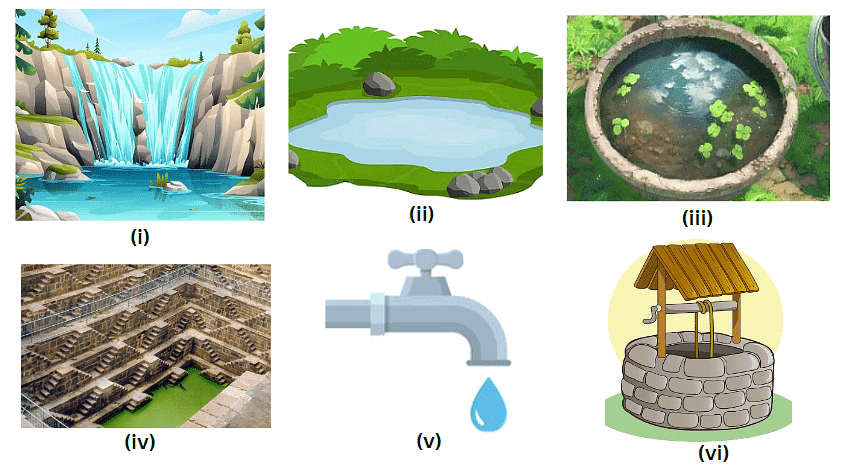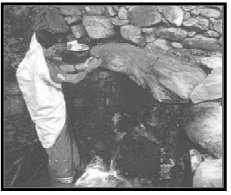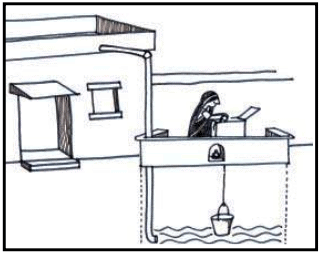Every Drop Counts - 1 Class 5 Worksheet EVS Chapter 6
Q1: Look at the different sources of water. Write their names in the blanks.
Lake, Pond, Step well, Sea, Water tap, Stream, Well, Rain, hand pump, Waterfalls.
 Ans: (i) Waterfall
Ans: (i) Waterfall
(ii) Lake
(iii) Pond
(iv) Stepwell
(v) Tap
(vi) Well
(vii) Stream
(viii) Sea
(ix) Rain
(x) Handpump
Q2: Choose the correct option.
(a) In the word Ghadsisar, what does the word Sar means.
(i) river
(ii) well
(iii) lake
(iv) pond
Ans: lake
(b) Johads were made to collect
(i)Tap water
(ii) Well water
(iii) Rain water
(iv) Flood Water
Ans: Rain water
(c) The arrangements of water for travellers was called
(i) sar
(ii) banvdis
(iii) piau
(iv) talabs
Ans: piau
(d) Who worked together to build a lake for Darki Mai’s village?
(i) Al-Biruni
(ii) Pawan Gupta
(iii) Tarun Bharat Sangh
(iv) King Ghadsi of Jaisalmer
Ans: Tarun Bhagat Singh
(e) What is the main message of the story?
(i) Water should be conserved and valued.
(ii) Old buildings and paintings can reveal history.
(iii) Al-Biruni was a famous traveller from Uzbekistan.
(iv) Stepwells are popular tourist attractions.
Ans: Water should be conserved and valued.
Q3: Fill in the blanks.
(i) Sar means a __________.
(ii) King Ghadsi of ____________ got made Ghadsisar lake 650 years ago.
(iii) Al-Biruni a traveller from ____________ visited India more than a thousand years ago.
(iv) Raised platforms around a lake are called ____________.
(v) Bavdis (Baolis) are ____________.
Ans: (i) Lake
(ii) Jaisalmer
(iii) Uzbekistan
(iv) Chabutaras
(v) Step wells
 |
Test - Every Drop Counts MCQ - 1
|
Start Test |
Q4: True/False
(i) The increasing population is also contributing to a shortage of water.
(ii) The soil around the trees should be covered with concrete and cement.
(iii) We should not pay the water bill.
(iv) We should put a motor pump directly in the Jal Board pipeline to overcome the water shortage.
(v) Rainwater should be collected in underground tanks for future use.
Ans: (a) True
(b) False
(c) False
(d) False
(e) True
Q5: Short Answer Type Questions
(i) Why were step wells, piaus, talabs built in the olden days?
Ans: Stepwells, piau, talabs were built as people in olden times thought it a good deed to provide water for thirsty travellers.
(ii) Name the sources of water.
Ans: The various sources of water are rivers, lakes, wells, hand pumps, tube wells, etc.
(iii) Who was Al-Biruni?
 Ans: Al-Biruni was a traveller from Uzbekistan.
Ans: Al-Biruni was a traveller from Uzbekistan.
(iv) Why did people come to the ghats of Ghadsisar?
Ans: People came to Ghadsisar to celebrate festivals and for music and dance programmes.
(v) Look at the picture. A bride was bowing to the spring. There is a custom in Uttarkhand state, after getting married new bride bows to the spring or pond in that village. A woman, Roopavati, is a new bride from Uttarakhand. Her husband is working in a city. How does Roopavati follow their custom?
A woman, Roopavati, is a new bride from Uttarakhand. Her husband is working in a city. How does Roopavati follow their custom?
Ans: By worshipping the tap in the new home.
 |
Download the notes
Worksheet Solutions: Every Drop Counts - 1
|
Download as PDF |
Q6: Long Answer Type Questions
(i) Who made Ghadsisar? Describe its structure.
Ans: Ghadsisar is a lake made by King Ghadsi of Jaisalmer 650 years ago. The construction of his lake was such that when the lake was full, the extra water flowed into another lake at a lower level—filling nine such interconnected lakes. The collected water was used throughout the year.
(ii) What is rainwater harvesting?
(or)
How do the people of Rajasthan save water? Ans: Rainwater harvesting is the accumulation and storage of rainwater for onsite reuse rather than allowing it to run off. Rainwater can be collected from rivers or roofs, and in many places, the water collected is redirected to a deep pit, a reservoir with percolation, or collected from dew or fog with nets or other tools. Its uses include water for gardens, livestock, irrigation, domestic use with proper treatment, indoor heating for houses, etc. The harvested water can also be used for drinking.
Ans: Rainwater harvesting is the accumulation and storage of rainwater for onsite reuse rather than allowing it to run off. Rainwater can be collected from rivers or roofs, and in many places, the water collected is redirected to a deep pit, a reservoir with percolation, or collected from dew or fog with nets or other tools. Its uses include water for gardens, livestock, irrigation, domestic use with proper treatment, indoor heating for houses, etc. The harvested water can also be used for drinking.
(iii) Why are wells drying up nowadays?
Ans: Because the water table gets lower than the inlet of the pump jet or submersion pump. The water table will become lower if over-pumped or the number of wells in the area increases. More wells in an area will lower the water table as there will be greater consumption from a well.
(iv) Why did people in Rajasthan not face water shortages in earlier times?
Ans: In earlier times there were many stepwell, piau and johads in Rajasthan so that time people didn’t face water shortages in earlier times.
(v) How did the group called “Tarun Bharat Sangh” help Dark Mai?
Ans: During summer, when the reservoirs dried up, they had to move to other places by leaving their village. Darki Mai heard about Tarun Bharat Sangh and requested help. Collectively, the people from the village and Sangh determined to make a pond. After the creation of ponds, the problem of food and water for animals has become less, and people have started getting more milk. Tarun Bharat Sangh (TBS) is a non-governmental association in Rajasthan. It is led by Rajendra Singh. The society and Rajendra Singh are best remembered for performing environmental research and land expansion to provide fresh and clean water to people.
|
38 videos|242 docs|41 tests
|
FAQs on Every Drop Counts - 1 Class 5 Worksheet EVS Chapter 6
| 1. How can we save water in our daily lives? |  |
| 2. Why is it important to conserve water? |  |
| 3. What are some simple ways to reduce water wastage at home? |  |
| 4. How does water conservation benefit the environment? |  |
| 5. What are some long-term solutions to address water scarcity? |  |






















